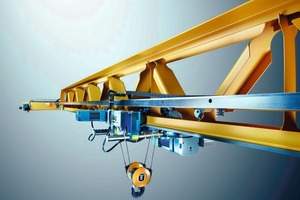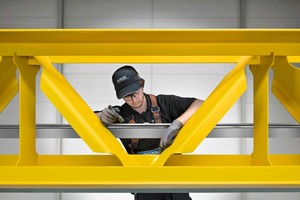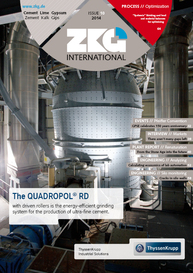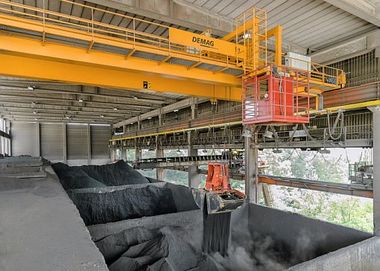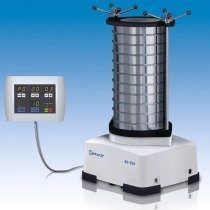Demag V-type crane: versatile, fast, long service life
Oscillation is a natural phenomenon that occurs in cranes. Lifting and travel motions result in forces that can cause a crane to resonate. That not only subjects the crane to loads. If the crane oscillates too much, it becomes difficult for the crane operator to handle loads precisely.
V-type design for efficient material flow
Whether for logistics, producers or machine manufacturers – all sectors of industry now face strong international competition. To maintain their position in today’s market, they need optimum efficiency throughout their material flow processes. “That already begins with fast and precise load handling”, explains Andreas Hambrock, Head of the Universal Cranes Business Line at Terex Material Handling. “We want to give our customers the best possible support with our cranes.” For this reason, the development of the Demag V-type crane focussed on factors such as handling rates, a high lifting-capacity-to-deadweight ratio, high load capacity and stability. Cost effectiveness and the certainty of a reliable investment also played an important role. “The goal of our engineers was to design a high-performance crane that operates with a high level of precision for a lower weight and longer service life.”
The result is a new design. “The crane girder is designed according to bionic engineering principles based on nature”, explains Andreas Hambrock. In a similar way to bone structure, material is only employed where it is necessary. Parts that are subjected to high loads are provided with additional stiffeners. Diaphragm joints provide for optimum dissipation of force and, at the same time, an even distribution of pressure and tensile forces. That makes the Demag V-type crane extremely resilient to loads. The result is a crane girder that weighs less, has better resistance against oscillation and offers double the service life. Terex Material Handling has patents pending for the new technologies incorporated in the Demag V-type crane.
Lower deadweight, higher load capacity
Thanks to its V-type design, Terex Material Handling has cut the deadweight of the girder by an average of 17 wt.‑% with reference to a comparable box-section girder. This enables companies to utilize any reserves offered by their building structures and – depending on the load classification of the relevant rope hoists – to increase the lifting capacity of their installations even further. In this way, they are able to transport greater loads and no longer have to operate in the upper load capacity range. The lower deadweight also means that V-type cranes exert lower wheel pressures and transmit lower loads to the existing building structure. Cranes can be integrated into existing workshops, assembly and production bays, often without the need for costly building refurbishment or changes to the building superstructure. In addition, the eco-friendly use of materials also helps to protect the environment.
Lower oscillation and improved precision
The optimized deadweight-to-lifting ratio and improved dissipation of force enable the crane to steady the load more quickly. Crane owners benefit from higher performance and improved handling rates, since crane operators can position loads more gently and precisely. And this can already be accomplished without the need for electronic control systems. The Demag V-type crane as standard already offers better performance.
A further benefit: thanks to its reduced oscillation characteristics, the entire crane installation, including its components, the crane runway and its supports as well as the building and its foundations are subjected to lower loads. This is reflected by reduced wear, for example. In addition, the crane also boosts cost-effectiveness, since heavier loads can be moved in existing building without the need for companies to modify the building structure. Furthermore: the Demag V-type crane can manage some 500 000 changes of load and, therefore, can achieve double the service life with reference to a comparable crane that has a box-section girder. That provides greater certainty of a reliable investment.
One crane to meet all
requirements worldwide
Thanks to its new design, the V-type crane is also suitable for outdoor operation, since its surface area that is exposed to the wind is up to 55 % smaller in comparison with crane that has a box-section girder. For indoor operation, the girder allows 30 % more light to pass through in comparison with conventional box-section girders, which provides for a brighter and more attractive working environment. The improved light situation also allows companies to save costs for indoor lighting. Besides allowing more light to pass through, the improved view also benefits safety at the workplace: users have an improved field of view and can see what is happening on the other side of the crane.
Compared to enclosed box-section girders, this benefit also pays off for service technicians, who can view the workshop through the crane girder. Since the design of the V-type crane affords a view of all weld seams, inspections and maintenance work can be carried out more easily.
In principle, most of the drive motor output is needed simply to move the crane. A further benefit of the new Demag V-type crane: the lower crane deadweight may enable motors with a reduced rating to be employed for improved energy efficiency. That saves operating costs and is kinder to the environment.
Emphasis was also placed on eco-friendly manufacturing processes for production of the crane. For example: the crane is blast-cleaned with dry ice before it is painted. The actual paints are water-soluble, thus avoiding the use of solvents that are harmful to the environment.
At the product launch, the V-type crane will initially be available in single-girder design in the form of overhead travelling, suspension, portal and wall-mounted travelling cranes. The overhead travelling and suspension cranes are available with spans of up to 30 meters and cover load capacities up to 12.5 tons. The Demag V-type crane is initially available in five different model variants for an optimum match with individual building contours. Depending on the situation – such as a beveled or sloping inclined roof or installed pipes and conduits – the shape of the crane girder end will vary accordingly. Thanks to the new variable design, the V-type crane can be adapted with millimeter accuracy to the height of existing or planned buildings and modified in line with specific needs. Experienced Demag sales engineers can configure the best possible girder design for the given application based on customer wishes with a completely new Designer Tool in advance. Example for the height: depending on how much space is available between the crane runway and the lower edge of the building, the corresponding X and U dimensions are entered into the Crane Designer system to determine the optimum height of the crane.
//www.terex.com" target="_blank" >www.terex.com:www.terex.com
//www.demagcranes.com" target="_blank" >www.demagcranes.com:www.demagcranes.com

